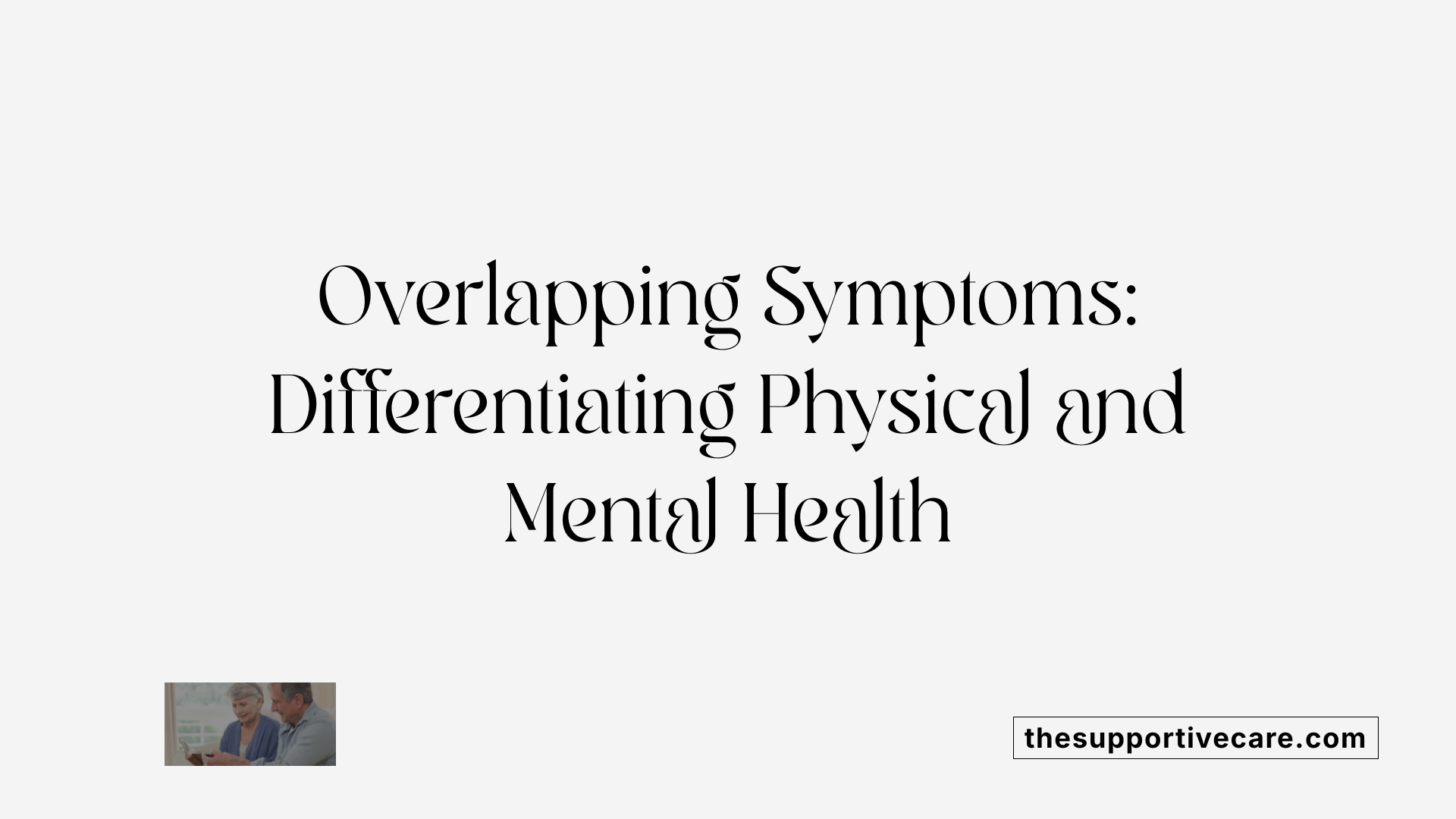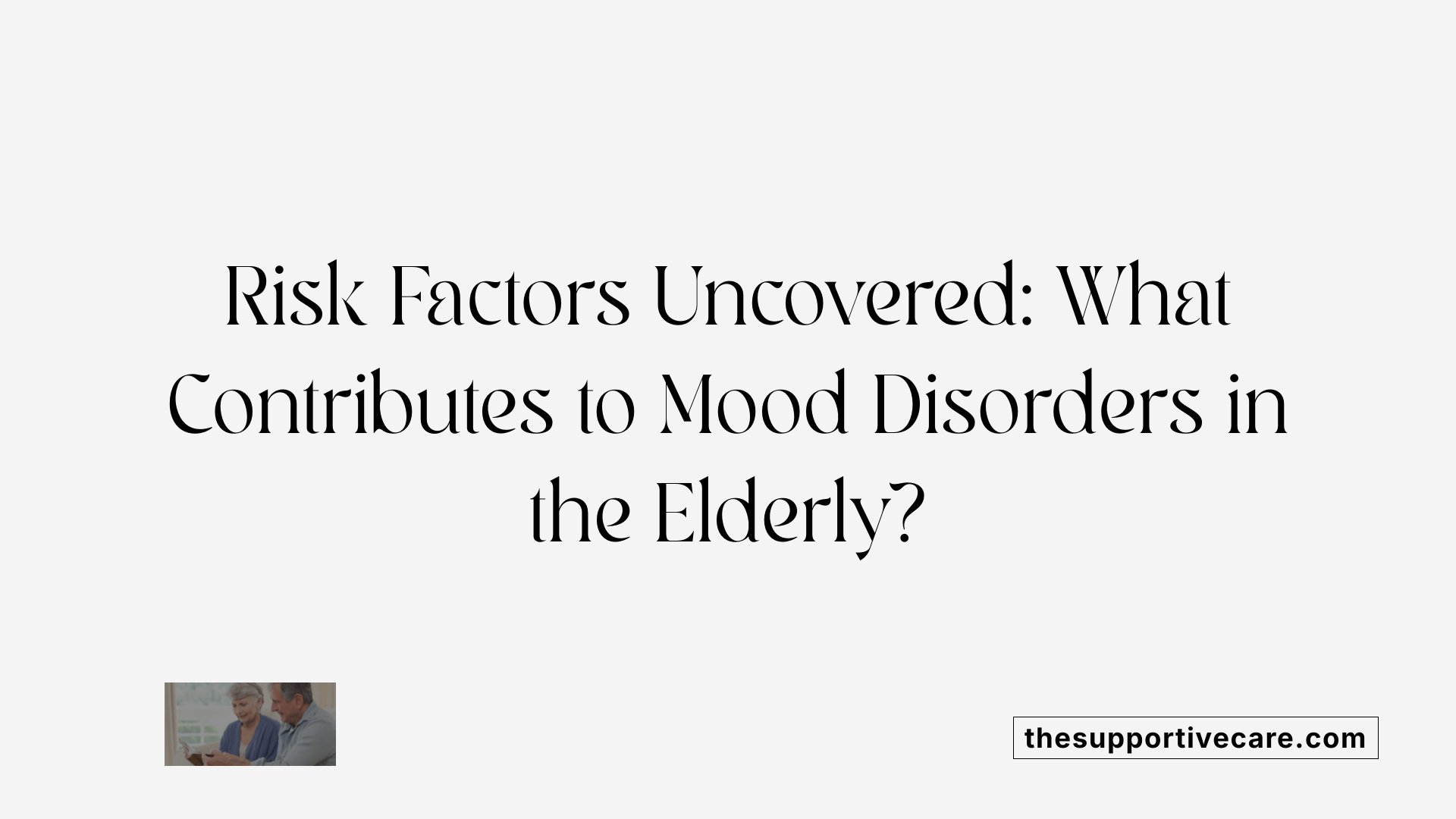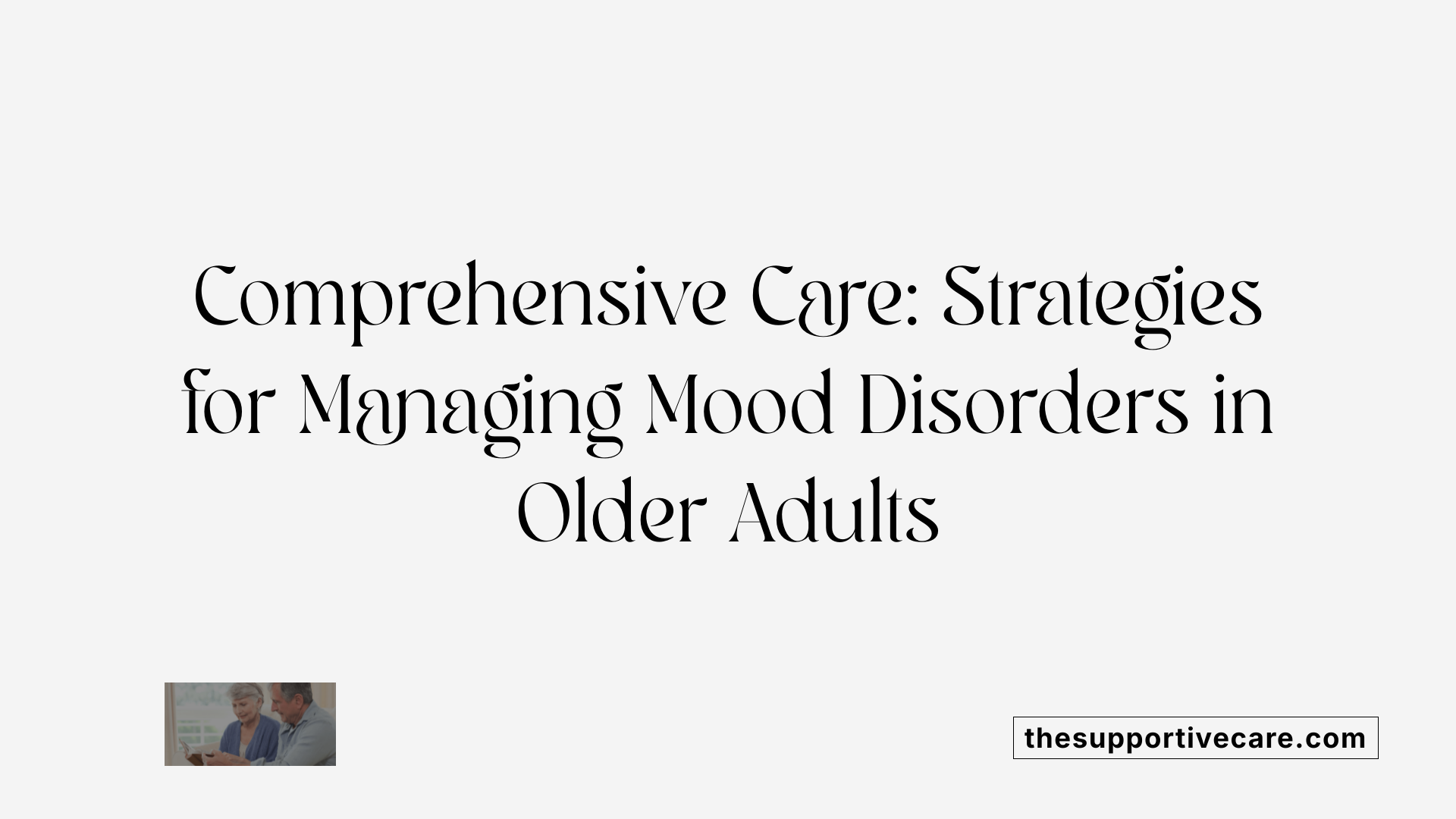Understanding, Managing, and Preventing Mood Disorders in the Elderly
As the global population ages, addressing mental health challenges among older adults becomes increasingly vital. Mood disorders, including depression and bipolar disorder, are prevalent yet often underrecognized issues that significantly impact quality of life and overall health. This article explores the types, signs, risk factors, and evidence-based strategies for managing and preventing mood disorders in older adults, emphasizing holistic and community-based approaches to promote mental well-being.
Recognizing Mood Disorders in Older Adults

What are common signs and symptoms of mood disorders in older adults?
Mood disorders in seniors often present with a mix of emotional, physical, and cognitive symptoms. Persistent feelings of sadness, anxiety, or emptiness are core emotional signs. Many experience loss of interest or pleasure in activities they once enjoyed, which can lead to social withdrawal.
Physical complaints are frequent, including aches, pains, fatigue, and sleep disturbances such as insomnia or oversleeping. Changes in appetite—either reduced or increased—are also common. These physical symptoms often make diagnosis challenging since they may resemble or be mistaken for other medical conditions.
Cognitive symptoms frequently involve difficulty concentrating, memory problems, or confusion—sometimes referred to as pseudodementia because they mimic dementia but are related to depression or anxiety.
Behavioral changes can include irritability, risk-taking, neglect of personal hygiene, or agitation. In severe cases, thoughts of death or suicide may occur, especially among high-risk groups like those with a history of depression or social isolation.
It's important to recognize that these symptoms can overlap with physical illnesses and that emotional responses to aging, such as grief or loss, may further complicate recognition.
How do symptoms sometimes overlap with physical health issues?
Atypical presentations of mood disorders may involve physical complaints like chronic pain, gastrointestinal issues, or fatigue that don't respond to standard medical treatments. Such somatic symptoms are common and can lead to misdiagnosis or delayed recognition of depression or anxiety.
Because aging often involves multiple health problems, mood symptoms might be attributed solely to physical ailments, overlooking underlying mental health conditions.
What about cognitive symptoms and their relation to dementia?
Cognitive issues such as memory lapses, difficulty concentrating, and slow thinking are common in older adults with depression. These symptoms can resemble early signs of dementia, especially Alzheimer’s disease.
Differentiating between depression-related cognitive impairment and true dementia is essential because treatment approaches differ. Mood disorder-related cognitive symptoms often improve with appropriate mental health treatment, whereas dementia symptoms tend to persist or progress.
Recognizing these overlapping features is vital for healthcare providers to deliver accurate diagnoses and effective interventions, ultimately improving quality of life for older adults.
Understanding Risk Factors Behind Geriatric Mood Disorders

What risk factors contribute to the development of mood disorders in older adults?
Several interconnected factors increase the likelihood of mood disorders, such as depression, among older adults. Medical conditions play a significant role; chronic illnesses like stroke, cancer, heart disease, Parkinson's disease, and thyroid problems can directly or indirectly influence mental health. These conditions often cause physical discomfort, functional limitations, and stress, which may precipitate or worsen mood symptoms.
In addition to medical issues, neurobiological changes associated with aging—such as brain volume loss, white matter lesions, and alterations in neuroendocrine systems—contribute to mood disorder risk. Vascular changes, for example, are linked to a subtype known as vascular depression, characterized by executive dysfunction and slowed psychomotor activity.
Psychosocial factors are equally important. Social isolation and loneliness are common in older age and strongly correlate with a higher risk of depression. The loss of loved ones, retirement, and decreased social engagement can lead to feelings of emptiness and hopelessness. Moreover, sleep disturbances, impairments like hearing or vision loss, and substance use—such as increased alcohol consumption or medication misuse—compound the risk.
Physical impairments and cognitive decline also set the stage for depression. Such issues may cause frustration and helplessness, further impacting mental health. Overall, a mixture of biological, medical, and social elements interacts, escalating vulnerability to mood disorders in seniors.
A Multidimensional Approach to Managing Mood Disorders

What strategies are effective for managing mood disorders in the elderly?
Effectively managing mood disorders in older adults requires a holistic and personalized plan that addresses not only the mental health symptoms but also the individual's overall health, environment, and social circumstances.
Pharmacological treatments are often tailored to accommodate age-related changes in metabolism and sensitivities. Selective serotonin reuptake inhibitors (SSRIs), such as sertraline, citalopram, or escitalopram, are typically recommended as the first-line medications due to their favorable side-effect profile. These medications should be started at low doses and gradually increased while monitoring for adverse effects like hyponatremia or bleeding.
Psychotherapy plays a vital role, with evidence supporting interventions like cognitive-behavioral therapy (CBT) and interpersonal therapy (IPT). CBT, in particular, helps modify unhelpful thought patterns and behaviors, improving mood and functioning. Group formats of CBT can also be beneficial, offering peer support and shared strategies.
Somatic therapies provide options for cases where medications and psychotherapy are insufficient. Electroconvulsive therapy (ECT) remains an important treatment for severe or psychotic depression, with newer techniques reducing cognitive risks. Transcranial magnetic stimulation (TMS) is gaining favor as a less invasive alternative with promising results.
Beyond medical interventions, lifestyle modifications are essential. Encouraging regular physical activity, balanced nutrition, quality sleep, and social engagement can significantly improve mental health. Addressing psychosocial factors—such as social isolation, loneliness, or grief—is critical, with activities like volunteering, community participation, and maintaining strong social connections shown to reduce depressive symptoms.
Overall, management should be highly individualized, considering each person's medical history, cognitive status, support systems, and preferences. Coordinated care involving primary care providers, mental health specialists, and social services fosters the best outcomes.
In summary, combining age-appropriate medication, evidence-based psychotherapy, somatic therapies when necessary, and lifestyle and social support constitutes a comprehensive strategy for effectively managing mood disorders among older adults.
Evidence-Based Medical and Psychotherapy Treatments
What evidence-based treatments are available for depression and bipolar disorder in older adults?
Managing depression and bipolar disorder in older adults involves a combination of medications, psychotherapy, and, in some cases, somatic therapies. The selection of treatment is tailored to each individual, considering age-related health factors and existing medical conditions.
Pharmacotherapy options and monitoring
For depression, second-generation antidepressants such as selective serotonin reuptake inhibitors (SSRIs) like sertraline and citalopram are often preferred due to their safer side effect profile. Serotonin-norepinephrine reuptake inhibitors (SNRIs) and norepinephrine-dopamine reuptake inhibitors (NDRIs) are also effective. It's critical to monitor for common side effects like hyponatremia and bleeding, especially in older adults who may be on multiple medications.
In bipolar disorder, treatment often includes lithium, which has neuroprotective properties and may lower dementia risk. Anticonvulsants such as lamotrigine and certain atypical antipsychotics like quetiapine or risperidone are also commonly prescribed, with careful dose adjustments to minimize adverse effects.
Psychotherapy interventions proven effective
Psychotherapy plays a vital role alongside medication. Cognitive-Behavioral Therapy (CBT), interpersonal therapy, and problem-solving therapy (PST) are effective modalities tailored for seniors. For example, Group-CBT focuses on current problems by addressing how thoughts, feelings, and behaviors are interconnected. Sessions usually occur weekly over 7 to 15 weeks, incorporating activities like mood logs and behavioral activation.
Psychotherapy helps modify unhelpful thinking patterns, increases social engagement, and enhances emotional regulation, all of which are particularly beneficial for older adults.
Advanced somatic therapies for severe cases
For severe or treatment-resistant depression, somatic therapies are available. Electroconvulsive therapy (ECT) remains one of the most effective treatments, particularly for psychotic depression or those with high suicide risk. Modern ECT techniques have reduced cognitive side effects, making it safer for older individuals.
Repetitive transcranial magnetic stimulation (rTMS) is an emerging alternative, offering benefits without anesthesia or seizure induction. It targets specific brain regions involved in mood regulation and has shown promising results.
Considerations for treatment individualization
Treatment plans must consider individual factors such as comorbidities, medication sensitivities, cognitive status, and functional abilities. Regular assessment and open communication between healthcare providers and patients are essential to optimize outcomes and minimize risks.
| Treatment Type | Typical Uses | Specific Considerations | Duration and Delivery |
|---|---|---|---|
| SSRIs, SNRIs, NDRIs | Depression, bipolar depression | Monitor for side effects like hyponatremia, bleeding; interactions | Daily, outpatient, over weeks to months |
| Lithium | Bipolar disorder, neuroprotection | Blood level monitoring, kidney and thyroid function | Long-term use, regular follow-up |
| Anticonvulsants (lamotrigine) | Bipolar depression, maintenance | Dose adjustments, skin monitoring for rash | Chronic, as prescribed |
| Atypical antipsychotics | Severe mood episodes, psychosis | Risk of metabolic syndrome, movement disorders | Short-term or maintenance |
| ECT | Severe depression, psychosis | Requires anesthesia, monitored cerebral function | Series over weeks, outpatient |
| rTMS | Moderate to severe depression | Less invasive, outpatient, fewer cognitive risks | Daily sessions over 4-6 weeks |
Effective management of mood disorders in older adults relies on an integrated approach, emphasizing medication safety, evidence-based psychotherapy, and advanced treatments for severe cases. Continuous evaluation and personalized care are essential to improve mental health outcomes.
Holistic and Community-Based Strategies for Mental Wellness
How can mental health be promoted and supported among older populations?
Promoting mental health in older adults requires a comprehensive approach that focuses on creating environments and opportunities that foster well-being. Developing age-friendly communities with accessible services ensures that older individuals can participate actively in social and physical activities.
Social connection plays a vital role in mental wellness. Community programs like befriending initiatives, social groups, and volunteer opportunities help reduce loneliness and social isolation, which are linked to increased depression risks.
Encouraging healthy lifestyle habits is equally important. Regular physical activity, a balanced diet rich in fruits, vegetables, and good-quality proteins, along with proper sleep, improve mental resilience. Managing vascular health and chronic conditions also supports emotional well-being.
Educational campaigns aimed at reducing ageism and stigma can foster acceptance and understanding. Intergenerational activities and public awareness efforts promote positive perceptions of aging and mental health.
Community-based programs and policy initiatives further bolster mental health support. Policies that address financial insecurity, affordable housing, and accessible transportation have tangible benefits for older adults.
Health services should incorporate evidence-based practices like cognitive-behavioral therapy, interpersonal therapy, and integrated care models that coordinate medical and mental health treatment. Providing support for caregivers through education, respite, and psychological services is also crucial.
Other strategies include promoting engagement through creative arts, mindfulness, and social skills training. These activities not only enrich lives but also build resilience against mental health issues.
In sum, a multidisciplinary approach combining supportive environments, healthy lifestyles, education, and accessible mental health services can greatly improve mental wellness in older populations, helping them maintain independence, satisfaction, and quality of life.
Designing Effective Intervention Programs and Policy Support
What are effective interventions and programs to improve mental well-being in older adults?
Improving mental health among older adults requires a mix of evidence-based strategies and community support systems. Psychotherapies like cognitive-behavioral therapy (CBT), interpersonal therapy, and problem-solving therapy are proven to help manage depression and anxiety. These can be delivered in group or individual formats, often over several weekly sessions to target current problems and enhance emotional regulation.
Beyond therapy, engaging in social activities and physical exercise programs significantly benefits mental health. These activities combat loneliness and social isolation, which are linked to higher depression rates in seniors. Community-based programs such as depression care management, befriending initiatives, and volunteer opportunities play a vital role in maintaining social connections and a sense of purpose.
Integrated and holistic care models involving multidisciplinary teams can address both physical and psychological factors influencing mood. Programs like collaborative care models ensure coordinated treatment, promoting early detection and continuous support.
Preventive strategies must also include policy and educational efforts to tackle ageism and abuse. Educating healthcare providers and caregivers, along with public awareness campaigns, fosters age-friendly environments and reduces systemic barriers. Creating accessible mental health screenings and early intervention pathways enables timely treatment, which can prevent escalation and improve quality of life.
Supporting vulnerable groups with tailored programs, family involvement, and person-centered approaches ensures treatments align with individual needs and cultural contexts. These comprehensive efforts collectively promote better mental well-being and help older adults maintain independence and life satisfaction.
The Power of Education and Awareness in Mental Health
How can education and awareness initiatives help address mental health issues in older adults?
Raising awareness and providing education about mental health are essential strategies to improve wellbeing among older populations. These initiatives enhance understanding of depression, anxiety, bipolar disorder, and other mood conditions that frequently affect seniors.
Public campaigns and specialized training programs like Mental Health First Aid empower older adults, their families, and caregivers with the skills needed to identify early signs of mental health struggles. Recognizing symptoms such as persistent sadness, irritability, social withdrawal, or changes in sleep and appetite can lead to earlier intervention.
Tailored messaging that considers cultural and linguistic differences ensures information resonates with diverse communities. This approach reduces stigma by normalizing mental health discussions, making individuals more comfortable seeking help.
Community-based programs also focus on building local capacity. Workshops, seminars, and peer-led groups foster environments where seniors feel supported and understood. These efforts not only promote timely treatment—such as psychotherapy, medication, or lifestyle changes—but also support long-term mental resilience.
By integrating mental health education into community activities, faith organizations, and healthcare settings, we reinforce the importance of addressing mental health as a vital component of overall aging. When communities are informed and empathetic, older adults are more likely to access resources, benefit from evidence-based interventions, and enjoy a higher quality of life.
Moving Forward: Building Resilience and Support Systems
Addressing mood disorders in older adults requires a multifaceted approach that combines early recognition, personalized treatment, holistic care, community engagement, and systemic policy support. By fostering awareness, reducing stigma, and providing accessible mental health services, society can significantly improve the quality of life for our aging population. Empowering older adults with social connections, healthy lifestyles, and education promotes resilience and mental well-being, ultimately creating communities where seniors can thrive with dignity and purpose.
References
- Depression and Older Adults | National Institute on Aging
- Mental health of older adults
- Recognizing and Treating Geriatric Mood Disorders
- How to Handle Mood Swings in Your Elderly Loved One
- Mood disorders in the elderly: prevalence, functional ...
- Depression Treatments for Older Adults
- 5 Ways Older Adults Can Improve Their Mental Health
- State TA: Supporting the Mental Health Needs of Older Adults
- The Impact of Aging on Mood Disorders




































































































